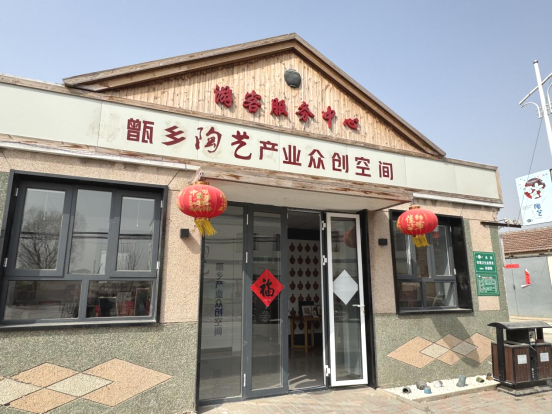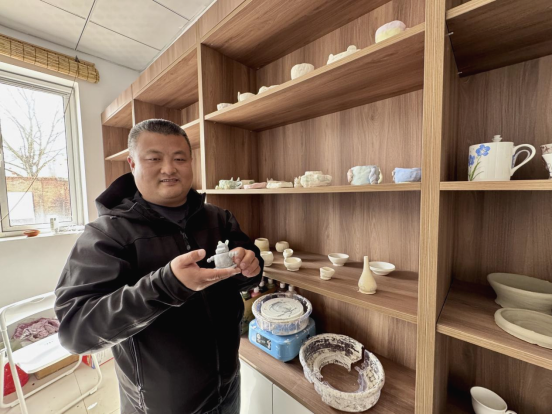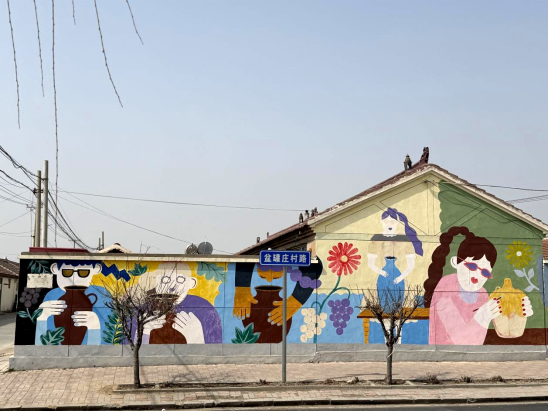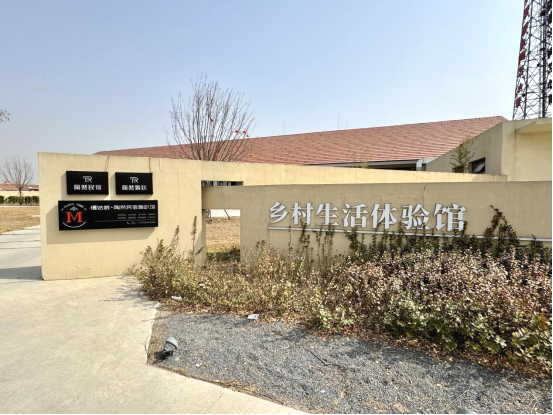Penguanzhuang Village: Support rural revitalization with Clay and E-commerce as a medium
In the spring, the light and shadow on the stone road are mottled, and the breeze blows the spring flowers and sway under the cultural wall. The clay flowing from the fingertips of the craftsmen next to the old kiln is gradually carved from the embryo to the mold, and then sealed into the brick kiln for firing, waiting for the next high temperature of the furnace fire and the glaze to collide with beautiful patterns on the clay. In the courtyard of the homestay next to it, the laughter of children is intertwined with the cheerful cry of small animals. This village, which was once silent due to the decline of the pottery industry, now uses clay as ink, so that ancient skills can ride the spring breeze of culture, and is writing a new chapter in rural revitalization.
Penguanzhuang Village, Banqiao Town, Ninghe District, is the only village named according to industry in Tianjin. It is 20 kilometers away from Lutai, 35 kilometers away from Tangshan, and 2 kilometers away from the Tanglang Expressway Banqiao Exit. It has a history of pottery making for more than 600 years and has the reputation of " the hometown of pottery". According to the genealogy of the Han family in Penguanzhuang Village: During the Yongle period of the Ming Dynasty (1403), a large number of Potters from Shandong and Henan settled here. At that time, there were more than 80 pottery workshops. In their heyday, almost every family made pottery, producing bowls, jars, rice bowls, flower pots and other daily necessities. In 2009, the handmade pottery skills of Penguanzhuang Village were approved by the municipal government to enter the Tianjin Intangible Cultural Heritage List, and Bentangzhuang Village was also named as a village with folk cultural characteristics in Tianjin.

From the earliest living utensils to building materials, and then to handicrafts with rich connotations, its shape, style and function are constantly changing, but what remains unchanged is the craftsmanship and oriental aesthetics rooted in this land. However, under the impact of industrialization, traditional pottery was in decline for a while, and the village was in trouble.
The business opportunities of Penguanzhuang Village began in 2019. The village was selected as the first batch of "municipal cultural tourism villages" in Tianjin. After a visit and investigation, Feng Chaochao, the person in charge, thought that there were three problems in the Penguanzhuang Village at that time: the non-heritage pottery inheritance personnel were disconnected, and there was no market support for future development; the occupancy rate of homestays with hardware standards was very low after the completion; although it was a tourism demonstration village, there was no really launch the Intellectual Property of ' the hometown of pottery' to create income for the residents.

In 2022, Feng Chaochao registered a TikTok account and walked into the kiln factory with his mobile phone for live broadcast. From sporadic viewers to fans, there were more than 10,000 views, and three months later, a pottery research video exceeded 110,000 views. Feng Chaochao and the team of village committee have seen the real money brought by views: in 2024, the overall income of non-heritage pottery reached 200,000 yuan, which is actually several times higher than the income in 2019.
With the views, the next step is how to use the hot spot to bring benefits to the residents and the village collective. Feng Chaochao turned his attention to the local chickens raised in the yards of every household. The village committee added one yuan to the wholesale price to buy them, and then hung the eggs on little yellow car in the e-commerce live broadcast room. "We have broadcast more than 300 live broadcasts from last year to now, almost every day. At the end of the live broadcast every day, we will drive an electric vehicle to collect local eggs on the spot, and then pack and ship them to everyone." Li Jin, the person in charge of the live broadcast room, said with a smile: "Now there are dozens of orders for single local eggs every day, and supply exceeds the demand. We plan to launch some agricultural products from surrounding villages and towns for everyone to buy."

Focusing on the layout of tourism in the whole area, the two committees in the village have carefully planned a boutique one-day tour route, which is connected with Qixing Island ecological sightseeing, Dayaowang Temple meditation culture, Hetou Old Street folk experience, pottery workshop and other characteristic nodes. Among them, the Penguanzhuang Village Homestay Cluster has innovatively launched experience projects such as starry sky camping base, Taoyun cultural and creative Market, and pastoral music party through functional upgrades.
With the increasing attention of intangible cultural heritage handicrafts, the local residents began to think about integrating the characteristics of " the hometown of pottery" into rural cultural tourism. The "Rural Life Experience Hall" located at the entrance of the village in Penguanzhuang Village is reflected in it. The shape of the pottery jar, the red tiles, and the interior space are in the style of a cave, which is very characteristic of " the hometown of pottery". There are not only young people who serve here, but also local residents.

By implanting the economic elements of night tour, Penguanzhuang Village has created a night tour product including open-air cinemas, bonfire parties, intangible cultural heritage exhibitions and performances, etc., so that the average stay time of tourists can be extended to 2 to 3 days, and the occupancy rate of homestays has been increased to 85%, driving the average income of residents to increase by more than 20,000 yuan.
At night, Feng Chaochao's mobile phone keeps popping up news: the live broadcast with goods has been approved for filing, millions of traffic support is in place, and the design team of Nankai University has sent new manuscripts. In the further blueprint, the sun shines through the ancient kiln ruins at the head of the village, and the lights of modern logistics vehicles draw a flowing galaxy on the country road. The story of the Penguanzhuang Village is being burned out the new glaze of rural revitalization in the collision of tradition and modernity. Those pottery jars that used to contain grains now carry the expectations of the residents, going further along the optical fiber and the highway. It is about to become a new landmark of rural tourism in Beijing, Tianjin and Hebei - the integration of ancient crafts and modern creativity paints a colorful picture of rural revitalization.
(TIANJIN AGRICULTURE AND RURAL COMMITTEE, Writer: Du Min; Translator: Ma Jiangpeng)
 京公网安备 11010802027341号
京公网安备 11010802027341号